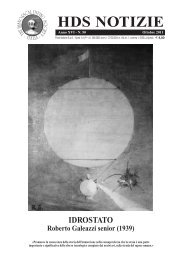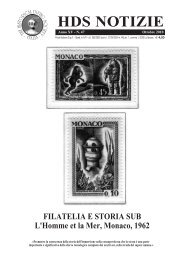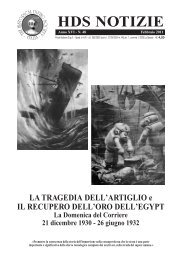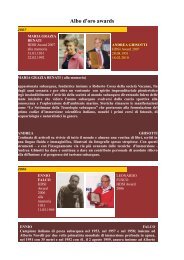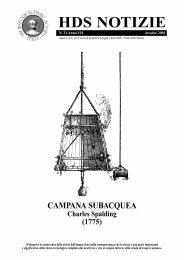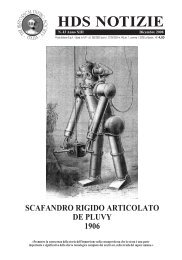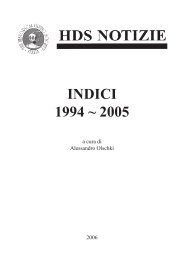hds internet - The Historical Diving Society Italia
hds internet - The Historical Diving Society Italia
hds internet - The Historical Diving Society Italia
Create successful ePaper yourself
Turn your PDF publications into a flip-book with our unique Google optimized e-Paper software.
mirabili...,1294). Bournes’ information then<br />
was available to anyone in England who could<br />
read Inventions and Devices or had the book<br />
read to them, without the need of using an academic<br />
as an intermediary to interpret a Latin or<br />
foreign text. Where Leonardo da Vinci understood<br />
the importance of buoyancy in diving 22) ,<br />
Bourne seems to have been the first to understand<br />
the mathematics involved. Though he did<br />
not get it completely right, as he only dwelt on<br />
his underwater boat being able to sink and rise<br />
again, thereby missing out on propulsion and the<br />
concept of neutral buoyancy, which appears to<br />
have first been first brought to light by Giovanni<br />
Borelli in his work De motu animalium (1680).<br />
As an almost certain copy of Bourne’s idea,<br />
Borelli’s own underwater boat had both oars and<br />
leather bags in which the amount of water could<br />
be adjusted so, as he put it, the boat, ‘could<br />
remain motionless in the middle of deep water’<br />
(figure 3). <strong>The</strong>re again, unlike Borelli, Bourne<br />
had put each of his ‘flexible leather containers’<br />
into a separate sealed orlop, so that if one burst<br />
the whole vessel would not be flooded 23) .<br />
After Bourne, early underwater boats enjoyed a<br />
well charted early development history, from<br />
Cornelius Drebbel (1618/20), to the submarine<br />
of American Robert Fulton (1800). While<br />
Richard Norwood (1613-), who may well have<br />
been influenced by Bourne’s book 24) , went on to<br />
introduce the diving bell (or ‘tub’ in his case)<br />
into Bermuda from where the design almost certainly<br />
migrated into the Caribbean and North<br />
America. Bourne’s description of the Venetian-<br />
<strong>Italia</strong>n diving bell surfaced again with the<br />
English philosopher Francis Bacon (1620), who<br />
described a tub on a tripod, ‘sometimes<br />
22) For Leonardo da Vinci’s ideas on diver buoyancy, see Codex<br />
Atlanticus, 333 r.a. (1487). Sorting out the relationship between<br />
pressure and volume not only explained why an air volume got<br />
smaller during the descent or larger on ascent, but more importantly<br />
why there was a parallel lose or gain of buoyancy.<br />
23) Alphonse Borelli, De Motu animalium, Naples, 1680 (opus<br />
post mortum). While Borelli appears to have used Bourne’s spiral<br />
rope shaped air trunk, he made no mention of the bell on three<br />
legs used by Bourne’s ‘Venetians and <strong>Italia</strong>ns who dive’, instead<br />
illustrating a bell in mid-water with a large weight suspended<br />
beneath (see figure 3).<br />
24) Norwood, who utilised an inverted barrel to recover ordnance<br />
lost overboard in Lymington harbour (1613), said that he got the<br />
idea from a book whose title he had forgotten. It was just as likely<br />
to have been Bourne’s book, as those of Tartaglia, Taisnier or<br />
De Marchi<br />
HDS NOTIZIE N. 23 - Giugno 2002 - pag. 15<br />
Dopo Bourne la storia dei sottomarini inizia la<br />
sua evoluzione, da Cornelius Drebbel (1618/20)<br />
al sottomarino dell’americano Robert Fulton<br />
(1800). Mentre Richard Norwood (1613-), che<br />
può ben essere stato influenzato dal libro di<br />
Bourne 24) , continuò a diffondere la campana<br />
subacquea (o ‘botte’ in questo caso) alle<br />
Bermuda da dove il progetto quasi certamente<br />
migrò ai Caraibi e nel Nord America. La descrizione<br />
di Bourne della campana subacquea veneziana-italiana<br />
tornò alla ribalta con il filosofo<br />
inglese Francis Bacon (1620), che descrisse una<br />
botte su tre gambe, ‘ impiegata talvolta sott’acqua<br />
sulle navi affondate’ 25) . Sebbene Bacone non<br />
facesse menzione del fatto che il subacqueo<br />
inspirasse aria prima di uscire nuotando per lavorare,<br />
sappiamo che questo metodo era ancora in<br />
uso in Inghilterra intorno al 1660.<br />
L’influenza più importante di Bourne sulla subacquea<br />
arrivò più di cento anni dopo la sua morte.<br />
Sulla scia delle operazioni di recupero di William<br />
Phips, che ebbero grande successo, al largo di<br />
Hispaniola nelle Indie Occidentali (1686/87),<br />
quando i suoi subacquei in apnea recuperarono da<br />
un relitto spagnolo una fortuna in oro per gli investitori,<br />
incominciò, col suo ritorno in Inghilterra,<br />
la febbre dei recuperi, con molti recuperi di relitti<br />
sparsi lungo le coste di Gran Bretagna, America,<br />
Caraibi e isole dell’Atlantico.<br />
Allora, negli anni intorno al 1690, durante un<br />
periodo di speculazione particolarmente intensa,<br />
ci furono diversi brevetti inglesi per attrezzature<br />
subacquee, molte delle quali con protezioni per<br />
braccia e gambe sporgenti, collegate alla superficie<br />
con tubi flessibili o rigidi, come alternative<br />
alla campana subacquea. L’unico progetto brevettato<br />
di quell’epoca giunto a noi è quello di<br />
John Williams che presentava una cabina resistente<br />
alla pressione collegata alla superficie<br />
attraverso un camino rigido (1692) (figura 4).<br />
Tale congegno, quasi certamente progettato alla<br />
luce di una migliore conoscenza della pressione<br />
idrostatica, può ben essere stato adattato dai progetti<br />
di Lorini (1596) o Borelli (1680), sebbene<br />
l’idea originale fosse chiaramente di Bourne.<br />
24) Norword, che utilizzava una botte rovesciata per recuperare<br />
l’artiglieria persa fuoribordo nel porto di Lymington (1613),<br />
diceva di aver preso l’idea da un libro di cui aveva scordato il<br />
titolo. È probabile si sia trattato del libro di Bourne, o di quelli di<br />
Tartaglia, Taisnier o De Marchi.<br />
25) Novum Organum, tr. William Wood, Lond., 1850, book 2,<br />
p.257



